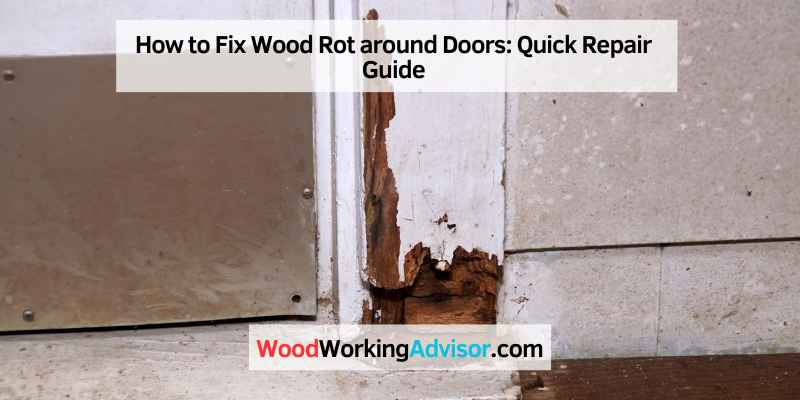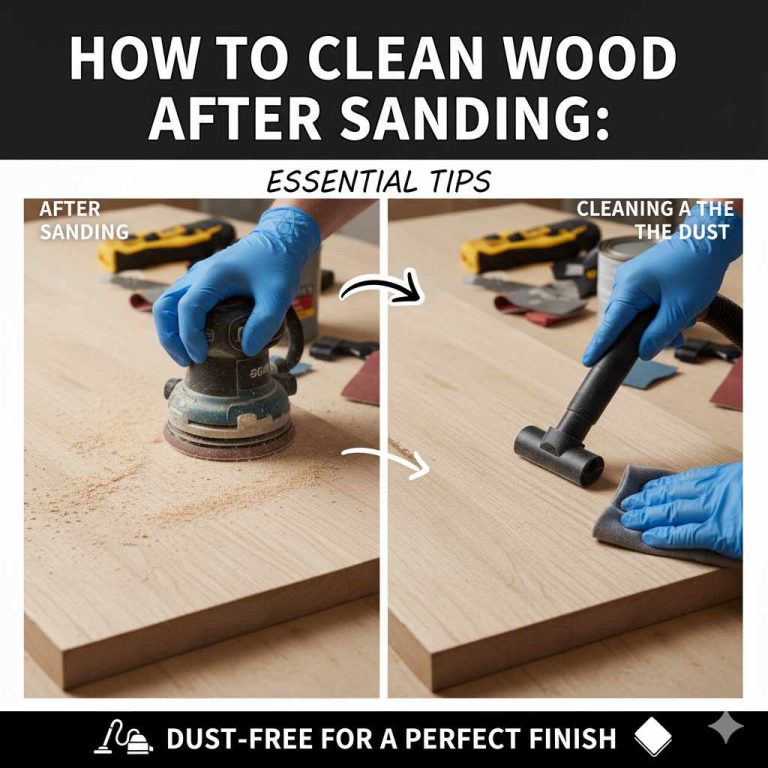How to Fix Wood Rot around Doors: Quick Repair Guide
To fix wood rot around doors, remove rotted wood, apply wood hardener, fill with wood filler, and repaint. Wood rot around doors is a common issue that can be easily fixed with the right tools and techniques.
In this blog post, we will discuss how to identify wood rot, the steps involved in fixing it, and preventative measures to avoid future damage. By following these simple steps, you can restore the beauty and integrity of your doors and prevent further deterioration caused by wood rot.
Let’s dive into the details of how to address wood rot around doors effectively.
Identifying Wood Rot
Wood rot around doors can be identified by soft, spongy areas or a musty smell. To fix it, start by removing any damaged wood and replacing it with a wood filler or epoxy. Then, sand and paint the area to prevent future rot.
Regular maintenance can help prevent wood rot in the future.
Wood rot is a common issue that affects many homeowners. It is caused by fungi that break down the wood fibers, leading to decay and structural damage. If not identified and fixed early, wood rot can spread quickly and lead to costly repairs. Therefore, it is essential to know how to identify wood rot, especially around doors, which are common areas for moisture to build up. In this section, we will discuss the signs of damage and the common affected areas of wood rot.
Signs Of Damage
The first step in identifying wood rot is to look for signs of damage. Here are some common signs of wood rot:
- Soft or spongy wood
- Crumbling or cracked wood
- Discoloration or staining
- Musty or earthy odor
- Presence of mushrooms or fungi
If you notice any of these signs of damage, it is likely that you have wood rot around your doors.
Common Affected Areas
Wood rot can occur anywhere there is moisture, but there are some common areas around doors where it is more likely to occur. These include:
| Common Affected Areas | Causes of Moisture |
|---|---|
| Door frames | Rain or snow, high humidity |
| Thresholds | Standing water, snow, ice |
| Sills | Standing water, snow, ice |
| Trim and molding | Leaky gutters, downspouts, or roofs |
It is important to inspect these areas regularly for signs of wood rot and fix any issues as soon as possible to prevent further damage.
In conclusion, identifying wood rot around doors is crucial to prevent costly repairs and ensure the structural integrity of your home. By knowing the signs of damage and common affected areas, you can catch wood rot early and fix it before it spreads.
Causes Of Wood Rot
Wood rot around doors can be caused by factors such as moisture, fungal growth, and insect infestation. To fix wood rot, start by removing the affected area, treating it with a wood preservative, and then filling it with an epoxy-based wood filler.
Finally, sand and paint the repaired area to restore its appearance and protect it from future damage.
Wood rot around doors can be a frustrating problem to deal with, but understanding the causes of this issue is essential for effective repairs. Two primary factors contribute to wood rot: moisture intrusion and lack of maintenance.
Moisture Intrusion
Moisture intrusion is one of the leading causes of wood rot. When water comes into contact with unprotected wood, it can penetrate the surface and lead to decay over time. There are several ways that moisture can infiltrate the wood around doors:
- Leaking or damaged gutters and downspouts: If your gutters or downspouts are not functioning properly, water can overflow and seep into the wood around your doors.
- Improperly installed or deteriorated caulking: Insufficient or deteriorated caulking around doors can allow water to seep in and cause wood rot.
- Condensation: High humidity levels or temperature differentials can lead to condensation, which can accumulate on the wood and contribute to rot.
Preventing moisture intrusion is crucial to avoiding wood rot. Regularly inspecting and maintaining gutters, downspouts, and caulking can help keep water away from the wood.
Lack Of Maintenance
Another common cause of wood rot is a lack of proper maintenance. Without regular care and attention, wood can become vulnerable to decay. Here are some maintenance-related factors that can lead to wood rot:
- Lack of protective finishes: Wood that is left untreated or lacks protective finishes like paint or stain is more susceptible to moisture damage and rot.
- Failure to address minor damage promptly: Neglecting to repair small cracks, splits, or damaged areas in the wood can allow water to enter and accelerate rotting.
- Insufficient ventilation: Poor airflow around doors can trap moisture and promote wood rot. It’s important to ensure that there is adequate ventilation to prevent this.
Regularly inspecting the wood around doors and addressing any signs of damage or wear can help prevent wood rot. Applying protective finishes and ensuring proper ventilation are also essential maintenance practices.
By understanding the causes of wood rot, you can take proactive measures to prevent it and maintain the integrity of your doors. Regular maintenance, addressing water intrusion issues, and providing proper protection will go a long way in preserving the beauty and functionality of your wooden doors.
Safety Precautions
When it comes to fixing wood rot around doors, safety precautions are paramount to protect yourself from potential hazards. Before diving into the repair process, it’s crucial to prioritize your safety with the appropriate protective gear and a well-organized working area setup.
Protective Gear
Wearing the right protective gear is essential to shield yourself from harmful substances and minimize the risk of accidents. Ensure you have the following protective gear before starting the repair:
- Safety goggles: Protect your eyes from wood dust, debris, and chemical splashes.
- N95 respirator mask: Filter out wood rot spores and dust to safeguard your respiratory system.
- Gloves: Choose durable gloves to shield your hands from sharp tools and chemical exposure.
- Long-sleeved clothing: Wear protective clothing to reduce skin exposure to chemicals and wood debris.
Working Area Setup
Creating a well-organized working area is crucial for a safe and efficient repair process. Follow these steps to set up your working area:
- Clean the area: Clear the work environment from clutter and debris to minimize tripping hazards.
- Ventilation: Ensure proper ventilation to reduce the concentration of fumes and airborne particles.
- Tool organization: Keep your tools organized and easily accessible to prevent accidents and save time.
- Workbench stability: Use a stable workbench or platform to provide a secure surface for repairs.
Initial Preparation
To fix wood rot around doors, you must start by preparing the affected area. This involves removing any damaged wood, cleaning the surface, and applying a wood hardener to strengthen the remaining wood. Proper initial preparation is crucial for a successful repair.
Before you can start fixing wood rot around your doors, it is important to properly prepare yourself and gather the necessary tools and materials. This initial preparation will ensure that you have everything you need to successfully tackle the task at hand. In this section, we will discuss the tools and materials you will require, as well as the process of removing the door.
Tools And Materials
To effectively fix wood rot around your doors, you will need a few essential tools and materials. Having these on hand will make the repair process smoother and more efficient. Here is a list of what you will need:
- Protective gloves and eyewear
- Mask or respirator
- Hammer
- Chisel
- Utility knife
- Screwdriver
- Putty knife
- Sanding block
- Wood filler or epoxy
- Primer
- Paint
- Paintbrush
Make sure you have these tools and materials readily available before you begin the repair process.
Door Removal
To effectively address the wood rot around your doors, it is necessary to remove the door from its frame. This will allow you to work on the affected areas more easily. Follow these steps to remove the door:
- Start by opening the door fully and supporting it in place with a doorstop or wedge.
- Use a screwdriver to remove the screws from the hinges that attach the door to the frame.
- Once the screws are removed, carefully lift the door off the hinges and set it aside in a safe location.
By removing the door, you will have better access to the wood rot and be able to address the issue more effectively.
Now that you have completed the initial preparation, including gathering the necessary tools and materials and removing the door, you are ready to move on to the next steps of fixing the wood rot around your doors. Stay tuned for our next section on assessing and repairing the damaged wood.
Assessing The Damage
Assessing the extent of wood rot around your doors is a crucial first step in the repair process. By understanding the scope of the damage, you can effectively plan and execute the necessary repairs to restore the structural integrity of the affected areas.
Extent Of Rot
Inspect the entire area around the door for visible signs of decay, including discolored or soft wood, as well as the presence of fungi or mold. Use a screwdriver to gently probe the wood and identify any areas that have been compromised by rot. Take note of the specific locations and the depth of the damage to accurately assess the extent of the rot.
Structural Integrity
Assess the structural integrity of the door frame and surrounding areas to determine the level of support and stability that has been compromised by the wood rot. Look for any signs of sagging, warping, or movement that could indicate a more severe impact on the overall stability of the structure. Pay close attention to any areas where the rot has affected load-bearing elements to ensure that the necessary repairs address these critical structural concerns.
Removing Rotted Wood
When dealing with wood rot around doors, the first step is to remove the rotted wood to prevent further damage.
Cutting Out Damaged Sections
Identify the extent of the damage, then cut out the affected areas using a saw.
Cleaning The Cavity
Thoroughly clean the exposed area to remove any debris or mold.
Repairing The Door Frame
Wood rot around doors can compromise the structural integrity of your home. Repairing the door frame is crucial to prevent further damage.
Epoxy Filler Application
- Clean the damaged area with a brush and vacuum.
- Mix the epoxy filler according to the manufacturer’s instructions.
- Apply the epoxy filler to the rotted wood using a putty knife.
- Smooth the filler to match the shape of the door frame.
Sanding And Shaping
- Wait for the epoxy filler to dry completely.
- Sand the filled area until it is smooth and even.
- Shape the repaired section to blend seamlessly with the rest of the frame.
- Ensure the surface is ready for painting or sealing.
Sealing And Finishing
To fix wood rot around doors, start by removing the affected wood and replacing it with a new piece. Then, seal the area with a wood hardener and apply wood filler to smooth the surface. Finish by painting or staining the repaired area to match the rest of the door.
Primer And Paint
Sealing and finishing the wood around doors is crucial for preventing wood rot. Choosing a high-quality primer will create a strong base for the paint to adhere to. Ensure the primer is specifically designed for exterior wood surfaces.
Weatherproofing Measures
Applying a weatherproof finish is essential to protect the wood from moisture. Consider using a sealant that is both water-resistant and UV-resistant. Regularly inspect the sealant for any signs of wear and reapply as needed.
Reinstallation And Maintenance

Proper rehanging of the door is crucial to prevent wood rot recurrence.
Door Rehanging
- Check hinges for rust or damage.
- Ensure the door is plumb and level.
- Apply a protective finish to seal the wood.
Regular Inspection Tips
- Inspect for cracks or peeling paint.
- Look for soft spots or discoloration.
- Keep door frames free from moisture.
Prevention Strategies
When it comes to protecting your doors from wood rot, prevention strategies are key. By implementing the following measures, you can effectively safeguard your doors and surrounding woodwork from the damaging effects of moisture and rot.
Proper Ventilation
Ensuring proper ventilation around your doors is crucial in preventing wood rot. Good airflow helps to reduce moisture buildup, which is a primary contributor to wood decay. Consider installing vents or fans to improve air circulation near your doors.
Routine Sealant Application
Regularly applying sealant to the wood surrounding your doors creates a protective barrier against moisture infiltration. High-quality sealants are essential for effectively sealing the wood and preventing rot. Schedule routine inspections to assess the condition of existing sealant and reapply as needed.
When To Call A Professional
For wood rot around doors, it’s best to call a professional if the damage is extensive or if you’re unsure of how to fix it properly. A professional can assess the situation and provide the right solution to prevent further damage and ensure the repair lasts.
While fixing wood rot around doors may seem like a manageable DIY project, there are instances when it is best to leave the job to the professionals. Complex repairs and guaranteeing longevity are two factors that may necessitate the expertise of a skilled carpenter or handyman.
Complex Repairs
When it comes to wood rot, not all damage is created equal. Some cases may be relatively simple to address, involving minor repairs and basic tools. However, if the rot has spread extensively or has affected the structural integrity of the door or surrounding areas, it is wise to call in a professional.
A skilled carpenter or handyman will have the knowledge and experience to assess the extent of the damage and determine the best course of action. They will be able to identify any underlying issues, such as water leaks or improper installation, that may have contributed to the wood rot. By entrusting the job to a professional, you can ensure that the repairs are done correctly and that any potential complications are addressed.
Guaranteeing Longevity
Fixing wood rot around doors is not just about making the immediate repairs; it is also about ensuring the longevity of the fix. A professional will have access to high-quality materials and tools that are specifically designed for wood repair. They will know which products to use and how to properly apply them to prevent future rot and damage.
Additionally, a professional will have the expertise to address any underlying issues that may have caused the wood rot in the first place. This could include improving drainage, addressing moisture problems, or recommending changes to the door’s installation or maintenance routine. By taking these preventive measures, a professional can help guarantee that the wood rot won’t reoccur in the future, saving you time, money, and potential headaches.
In conclusion, while there are instances when fixing wood rot around doors can be a DIY project, there are times when it is best to call a professional. Complex repairs and the desire for long-lasting results are two factors that warrant the expertise of a skilled carpenter or handyman. By entrusting the job to a professional, you can ensure that the repairs are done correctly and that any underlying issues are addressed, guaranteeing the longevity of the fix.

Frequently Asked Questions
How Can I Identify Wood Rot Around Doors?
Wood rot can appear as discolored, soft, or crumbly wood. Look for fungal growth or a musty smell. Use a screwdriver to probe the wood for soft spots. Pay attention to areas prone to moisture, such as the bottom of the door frame.
What Are The Common Causes Of Wood Rot Around Doors?
Wood rot is often caused by prolonged exposure to moisture, such as rainwater or condensation. Poor ventilation, plumbing leaks, and high humidity levels can also contribute to wood rot. Additionally, untreated wood and lack of protective coatings can make the wood more susceptible.
How Can I Prevent Wood Rot Around Doors?
Regularly inspect and maintain the door’s exterior, including repainting or resealing as needed. Ensure proper drainage to prevent water from pooling near the door. Keep the area well ventilated and address any plumbing leaks promptly. Consider using pressure-treated or rot-resistant wood for repairs or replacements.
What Are The Repair Options For Wood Rot Around Doors?
Depending on the extent of the damage, options may include filling with an epoxy filler, using wood hardeners, or replacing the affected wood. It’s important to address the source of moisture to prevent future rot. Consult a professional if the rot is extensive or if structural integrity is compromised.
Conclusion
Overall, fixing wood rot around doors can be a daunting task, but it is essential to maintaining the integrity and appearance of your home. By following the steps outlined in this guide, you can effectively identify and address wood rot, preventing further damage and costly repairs.
Remember to always prioritize safety, and don’t hesitate to seek professional help if needed. With the right tools and techniques, you can restore your doors to their former glory and enjoy a beautiful, long-lasting finish.







